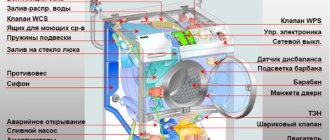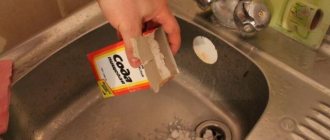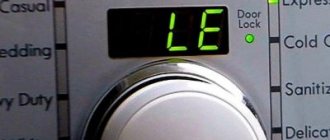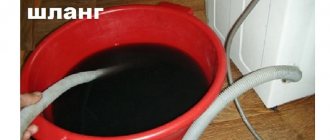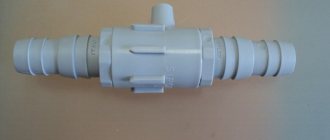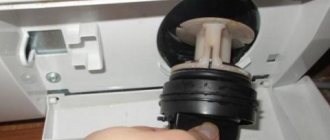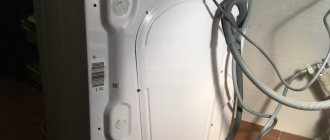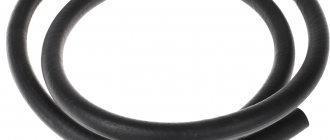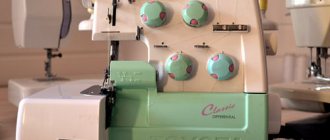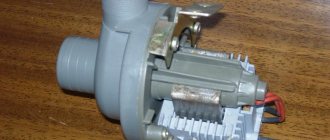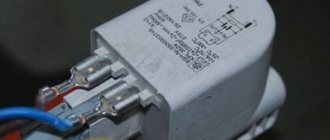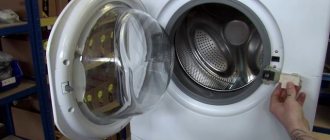Operating principle
Each washing machine includes two hoses. As you guessed, we are talking about the fill and drain hoses. During the installation process, you need to make sure that there are no cracks, bends, punctures, and so on. The filler connects directly to the water supply. The drain is connected to the sewerage channel, which can be extended if necessary. Next we will look at the installation process in more detail. Now we point out that the inlet hose is made with a union nut at both ends. The internal thread in all machines is standard, its diameter is 3/4 inch. An important factor that should be taken into account is the location of the washing machine.
The location of the machine affects not only the correct operation, but also the pouring process. We are talking about the following factors:
- closest location to the water supply line;
- the presence of a way to drain water;
- some machines are mounted into the wall (accordingly, you need to make the correct water supply);
- there should be enough space for the inlet and drain hoses;
- The installed hose must not be bent.
Inlet hose fastener
Adapter for connecting the inlet hose
How to connect the drain hose to a washing machine
Replacing a drain hose takes much more time because the drain hose is attached to the “internals” of the equipment and its design is more intricate than other parts. The hose is connected to the pump at its head, so you will need to disassemble the machine to begin with. Depending on the manufacturer, the hose will come out at the top or bottom of the housing. To do this, you will need to disassemble the washing machine from the back. We follow the step-by-step instructions:
- Turn the washing machine over to its right or left side. This will make it easier to disassemble the lower part.
- Unscrew several self-tapping screws located on the back side to loosen the cover.
- Push the cover towards the back of the device
- Remove the cover
Ready! Now you can calmly begin disassembling and understand how and where the hoses of your washing machine are hidden. Different models have internal parts arranged differently, so when replacing, some nuances should be taken into account.
Drain hose
Additional installation options and leak prevention
A separate installation option is to create a special outlet in the system. This option requires a lot of money, but also has its advantages. For example, in the event of a breakdown or other malfunction of the washing machine, you will not need to disconnect it from the water supply. It will be enough to install a tap to shut off the water supply in the event of a breakdown. Also, an additional outlet can be made of a flexible pipe that has a union nut (American). Avoid overly large elbow joints that affect water pressure.
To avoid leaks, plumbing uses a special fum tape that is wound directly onto the threads. Plumbers distinguish all connecting elements into two types: internal and external threads (the so-called male and female). Fum tape must be carefully wound around each turn of the thread. Also make sure that the wound layer is not loose or too tight. Otherwise, the foam will not seal the gaps, or it will simply tear. There is no need to use liquid silicone, which over time leads to rusting of the connecting elements. To prevent the inlet hose from breaking, it should not be subjected to mechanical stress. Avoid entangling with the drain hose.
Insertion into metal plastic using a tee
Connecting the inlet hose to the washing machine
An example of connecting to a water supply using a crimp coupling
Varieties
Before you begin lengthening, you need to familiarize yourself with the main types of hoses.
Jellied
The inlet hose is a device used to connect the washing machine to the water supply system. It is with its help that water is supplied to the internal elements of the system. Such products operate under high pressure conditions and therefore reinforcement technology is used in their manufacture.
The main material from which the filler tubes are made is polyvinyl chloride, the surface of which is covered with nylon.
The connecting components of the structure can be made of steel, aluminum or plastic. Budget models use plastic fittings that are unscrewed and screwed on manually, without the use of additional tools. When working with steel or aluminum products, you will have to use a special wrench.
Drain
A drain hose is used to drain liquid from washing equipment. The following types of drain tubes are distinguished:
- Standard. Such products are produced in a certain length, the length of which can reach five meters.
- Telescopic. These are corrugated products that can easily be stretched to the desired length. When connecting telescopic tubes, you must be very careful so that they do not bend. The kinks may burst under strong pressure.
- Polypropylene. They are made from durable polypropylene. At each end of the product there are special fittings with which a device for washing clothes is connected.
Aqua-stop systems for flexible inlet hoses
Such systems protect washing machines from leaks. All washing machines according to the degree of protection are conventionally divided into three types: defenseless, partially protected and completely protected from leaks. One of the varieties of the Aqua-Stop partial leakage protection system is a valve that is installed between the supply tap and the inlet hose. Its operating principle is to determine the pressure difference. If it is completely torn off, then such a valve will immediately work if the flow rate of the outgoing stream exceeds 10-13 l/min. If the seal was broken and it was simply cracked, then such a valve will not work.
There are Aqua-Stop hoses that partially protect washing machines from leaks or large amounts of water. Its design feature is a high-pressure hose, which is built into the main inlet hose. If it breaks or its aluminum extrusion weakens, the water will reach the block in which the absorbent is located. After water enters, the absorbent will expand. This will cause the fuse to move under the influence of the expansion of the absorbent, which will close the water supply valve. If your washing machines do not have any protection against leaks, then using such systems will help you avoid this. The only drawback is that if it breaks, you will need to completely change it.
Let's consider the last type of leakage protection, which uses an electromagnetic valve with a float on the pan (Aqua-stop). Such protection against grooves is called complete. In this case, the inlet hose does not contain absorbent, but an adjusted solenoid valve, which has a special drain program built into it. When you need to pump water, voltage is applied to the valve, it opens and water flows to the washing machine. When the water has filled up, this valve closes and the machine continues the program wash. If it has been partially damaged and liquid leaks out, then through the internal drainage system the water enters the pan, which is equipped with a special float. When the liquid in the pan reaches a certain level, the float closes contacts that close all solenoid valves. Such a system guarantees complete protection against leaks, even if water leaks from the washing machine itself.
The inlet hose breaks quite rarely. However, if this does happen, then such systems will help avoid negative consequences. It can also be extended if necessary.
Inlet hoses with Aquastop system
Optimal service life
A breakdown can lead not only to flooding of your own room, but also of your neighbor’s. To prevent this, you need to change them in time. Typically their service life ranges from 1 to 10 years. Most sellers provide a warranty that does not exceed 1 year, and it is almost impossible to determine the full service life. Therefore, you need to constantly monitor their condition and change them if necessary. This is especially true for the drain hose, through which all outgoing waste flows.
An ordinary faucet can significantly increase the service life. It is installed in the tee before water intake into the machine. If you close it after washing, the inlet hose will not be constantly under water pressure. Keep in mind that it is rubber and should not be exposed to sudden changes in temperature, otherwise it may crack.
Connecting a washing machine
Popular manufacturers and prices
The set of inlet hoses for washing machines is selected by the manufacturer. The brand of hose that is included in the kit depends on the type of washing machine. The quality of the washing machine is proportional to the quality of the inlet hose. Let's look at the most popular options.
| Manufacturer's name | Technical features | Footage / cost |
| Electrolux | · Equipped with Aqua-stop system; · Maximum permissible temperature 900 C; · Withstands pressure up to 90 Bar. | 1.5 m – 800 rubles |
| Reflex | · Double-layer tube; · Additional protection against leaks; · Withstands pressure up to 20 Bar; · Equipped with nuts that prevent the hose from unwinding; · Maximum permissible temperature 250 C. | 1.5 m – 150 rubles |
| Scanpart | · Withstands pressure up to 90 Bar; · Used as an inlet hose. | 2.5 m – 900 rubles |
| CODO | ·Metal base; · Equipped with an additional metal sleeve. | 1.5 m – 160 rubles |
| Cotali UDI-Black | · Maximum permissible temperature 1000 C; · Withstands pressure up to 80 Bar; · Working capacity of water transmission 43 liters per minute. | 2 m - 360 rubles |
It's impossible to say which model is better. We only point out that each is selected based on a specific case. For example, if you have high pressure in the system, then you need to choose an inlet hose that can withstand it. Also, if you want to protect yourself from leaks, then choose Aqua-Stop hoses. If you feel that the hose is about to break, then it needs to be urgently changed and, if necessary, extended.
Filler hose, reinforced
To all these types of water supply networks, the inlet hoses are connected in almost the same way. The only difference is the design and the different material options used. If necessary, the hose can be extended.
Additional Tips
If you do not have sufficient experience in installing plumbing, then you do not need to connect the machine to the water supply yourself. Lack of knowledge can lead to pressure drops, leaks, or even loss of operation of the washing machine. In almost every city there is a technician who can connect the inlet hose, extend it, or completely connect the machine.
In places of threaded connections, it is necessary to use grease in order to increase the service life of the connecting elements. Also try to avoid getting moisture into the threaded connections, which can cause corrosion.
If you are using an American model, the installation of which we described above, then make sure that the union nut moves freely along the thread. There may also be defects, and the union nut will slip, and the joints will not have the necessary seal, which in turn will lead to leakage.
Periodically clean the filter that is installed on the filler hole. Rust, plaque or other similar debris may accumulate on it. Clean filters help to improve the quality of the incoming water. Accordingly, clean water increases the service life of the machine.
Thus, we looked at the process of correctly connecting the inlet hose for a washing machine, as well as extending it and the drain hose if necessary. This process is quite simple. Now you can use our article as a step-by-step guide. We hope that you have found the material that interests you.
Purpose and features of the connection
Before you start extending the drain hose, you need to become familiar with its main purpose and the features of its connection. This design is used to drain water from washing equipment into the sewer system. The efficiency of draining liquid depends not only on the integrity of the structure, but also on the characteristics of its connection to the sewerage system and the washing machine. To connect the tubes, connecting elements - fittings - are used. They are installed on the hose and ensure its secure fastening.
For additional fixation, use a special rubberized or metal coupling. It is installed to the pipe responsible for removing liquid.
